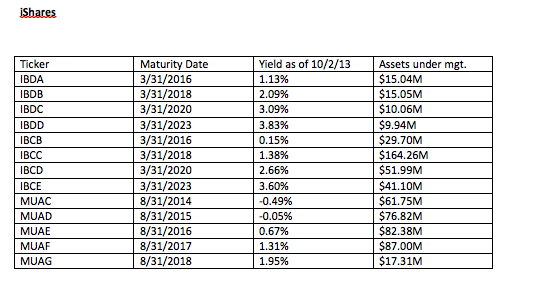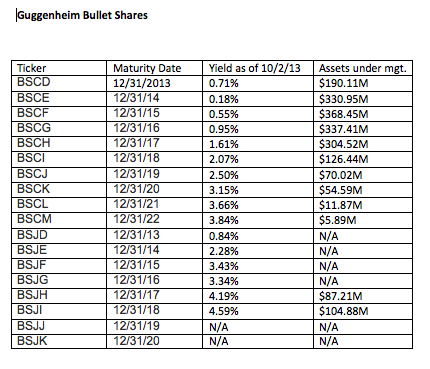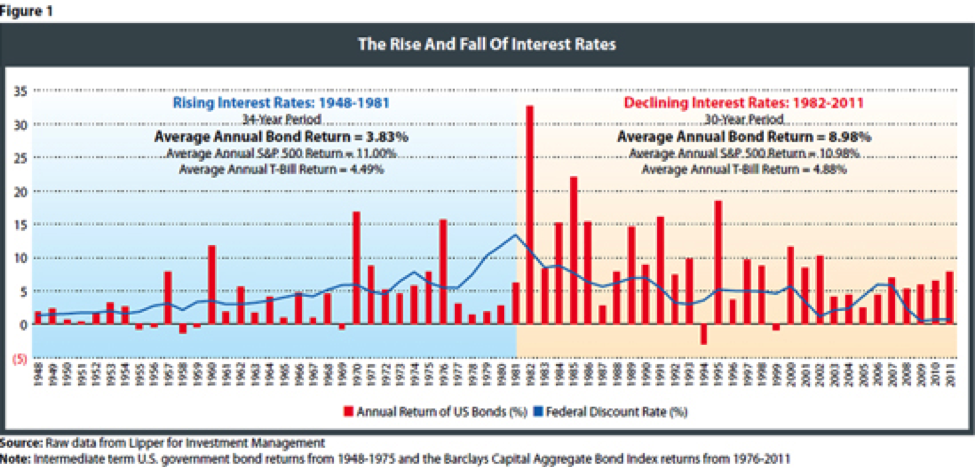Recently the Fed announced that the $85 billion bond purchase by the Treasury will continue. Up until this point the financial news media seemed sure that the Fed would pare back their stimulus program. Apparently, now is not that time. But at some point in the future, the Fed will need to change its course. When it happens, bond prices will be under downward pressure as interest rates rise. Many investors, especially retirees and conservative minded-investors are purchasing bonds either individually, through a bond mutual fund or a bond exchange traded fund (ETF). Investors seem to associate bonds with safety, but this may not be the case going forward. How can you protect your bond portfolio in these uncertain times?
Defined maturity bond ETFs are relatively new to the financial industry. The providers in this space are currently Guggenheim’s Bulletshares and iShares. These ETFs specifically aim to tackle interest rate risk and protect yield to maturity. When purchasing a defined maturity ETF the investor is receiving a basket of 100 to 200 bonds with a maturity date set for the year within the name of the fund. For instance the Bulletshares 2020 fund will mature on Dec 31, 2020. When this happens the fund is liquidated and the proceeds are sent back to the investors.
Because this bond vehicle is an ETF, it can be purchased and sold during trading hours making it very liquid and transparent as the holding are disclosed daily. For investors that purchase the fund, reinvest the payouts, and hold until fund maturity (and assuming that there are no company defaults within the portfolio) principal is protected. If principal is not reinvested you will lose some yield because that money would otherwise be reinvested at positive an interest rate.
The defined maturity ETFs currently on the market all pay the investor monthly. Regardless of interest rate movement you will receive your locked-in yield, either in the form of interest payments or principle repayment at maturity, depending on interest rate movements and assuming that you hold the product until maturity. In other words your monthly payment distributions will vary with interest rates; but to ensure the locked-in yield at your purchase NAV price, your principal repayment at maturity will adjust.
Defined Maturity ETFs vs. Individual Bonds
The defined maturity bond ETF is similar to an individual bond in its definitive maturity date but the similarities stop there. Holding individual bonds increases the investors’ default risk. Holding a basket of 100 to 200 bonds does not eliminate this risk but it does mitigate it significantly. Individual bonds also may lack proper liquidity should an investor want to get out early. Quality offerings are harder to find, and most individual bonds pay semi-annually. Similar to individual bonds, the defined maturity bond ETFs can be laddered to create the income and or duration goals of the portfolio.
Defined Maturity ETFs vs. Mutual Funds
Bond mutual funds have only the bonds’ asset class in common with defined maturity bond ETFs. Bond funds do not trade intra day and only disclose holdings quarterly making them less transparent. They are designed to target a duration such as short, intermediate and long term holdings, and have to sell bonds out of the portfolio to maintain their duration mandate. Many of the bond funds are actively managed bringing in additional risk of manager mistakes. The cost of holding a bond mutual fund is also higher when comparing fund fees and undesired capital gains passed through to the investors.
Defined Maturity ETFs vs.Traditional Bond ETFs
Defined maturity bond ETFs are similar to traditional bond ETFs in how they trade and in transparency. The main difference is traditional bond ETFs are built for perpetuity. Traditional bond ETFs are better used to simply gain exposure to bonds and asset class movements, as their future income is difficult to predict. For more aggressive investors or accounts that are smaller in size, this vehicle is desirable. For more conservative to moderate investors approaching or in retirement, the defined maturity bond fund offerings appear to be a better choice when executed properly.
Guggenheim VS. iShares
There are various defined maturity ETF products in the market. iShares offers these products in the form of municipal bonds and corporate bonds. Guggenheim offers defined maturity ETF’s in the form of their Bulletshares, using corporate and high yield corporate bonds. Defined maturity ETF’s from iShares and Guggenheim are indeed similar yet have some notable differences. We compare the corporate 2018 defined maturity ETF’s of both providers below.
SharesBond™ 2018 Corporate Term ETF (IBDB) vs. Guggenheim BulletShares® 2018 Corporate Bond ETF (BSCI)
We can see the expense ratio is lower using iShares’ IBDB, however the yield is slightly greater using Guggenheim’s BSCI. Also note that the bid/ask spread is markedly greater using IBDB, decreasing tradability. If we hold these defined maturity ETF’s until maturity tradability becomes less important if the investor achieves the desired NAV purchase price to begin with.
Another difference in the products is how they unwind when they near maturity. With iShares, during the final 12 months of the ETF, as the individual bonds mature the money is transitioned into cash and cash equivalents. Guggenheim utilizes the same basic approach except that they time this process to coincide with the final 6 months instead of 12 months. While the iShares approach is technically safer, it can be argued that the yield to maturity suffers because of the earlier transition into lower yielding cash instruments.
Both iShares and Guggenheim provide a yield to maturity calculator tool on their website for each of their specific defined maturity ETFs. This provides investors a great tool to enter the NAV price at point of purchase and see what their yield will be. The yield will hold as long as the investor holds the ETF to maturity and no bond defaults. As discussed earlier, risk of default is mitigated by these ETF’s holding a basket of many bonds (usually 100-200) and default has been rare. In 3 years Guggenheim has only had one bond default in their high yield corporate category, and this had a very small effect of yield due to diversification and capping.
The current list of defined maturity ETF products can be found below.

Execution Risks
Investors will want to place a limit order as opposed to a market order when trading defined maturity ETFs. A market order will fill at the “market price” at the time the trade is placed. However, with a market order an investor may not get all the requested shares at one price or may get a very inefficient price in thin trading. This occurs because of frequent price fluctuations, and share availability at a given price. These fluctuations are undesirable because yield is predicated on the purchase price of the ETF. With a limit order, the order will not fill unless all the shares requested can be purchased at or below the investors specified price, which should be set close to the funds NAV.
Bonds in this Environment
Bond prices will deviate from par value based on changing interest rates. However, as maturity nears, the price will converge and settle at face value. The past few years have been especially tricky for investors in the bond market. The prime suspect for this dilemma has been low interest rates. When interest rates rise bond values decline because the coupon payments are based on these interest rates. Conversely, when interest rates drop bond values climb. Solely based on this an investor may think why should I even bother investing in such instrument, when interest rates are already so low?
The answer is diversification and client behavior. Interest rates are low, and based on current headlines and economic valuations, investors could choose to stay away from bonds. However, portfolio diversification with a long-term focus calls for holding at least the core asset classes including bonds. Holding bonds today give the portfolio a solid foundation for the next unanticipated crisis.
When the stock market is climbing investors tend to move to stock when they feel better, causing them to buy near the top and sell the bonds at the bottom. Then when the market falls they want to get out because it feels bad to lose, causing them to sell the stock low and buy the bonds high. This cycle only hurts the portfolio, yet it is what we seem to think is normal – i.e., if the house is on fire you get out. In portfolio management, successful investment strategies using long term approaches such as those at Vanguard are not exotic or nor do they provide for great water cooler talk, but the results speak for themselves. The bottom line is you want to hold bonds to protect you from you. The defined maturity bond ETFs are new products allowing you to do this a little smarter.
The figure below illustrates periods of rising and falling interest rates, during both periods, bond returns have been positive.
Adam Ton contributed to this article.
- English (UK)
- English (India)
- English (Canada)
- English (Australia)
- English (South Africa)
- English (Philippines)
- English (Nigeria)
- Deutsch
- Español (España)
- Español (México)
- Français
- Italiano
- Nederlands
- Português (Portugal)
- Polski
- Português (Brasil)
- Русский
- Türkçe
- العربية
- Ελληνικά
- Svenska
- Suomi
- עברית
- 日本語
- 한국어
- 简体中文
- 繁體中文
- Bahasa Indonesia
- Bahasa Melayu
- ไทย
- Tiếng Việt
- हिंदी
Retooling Your Bond Portfolio With Defined Maturity ETFs
Published 10/03/2013, 01:47 AM
Updated 07/09/2023, 06:31 AM
Retooling Your Bond Portfolio With Defined Maturity ETFs
3rd party Ad. Not an offer or recommendation by Investing.com. See disclosure here or
remove ads
.
Latest comments
Install Our App
Risk Disclosure: Trading in financial instruments and/or cryptocurrencies involves high risks including the risk of losing some, or all, of your investment amount, and may not be suitable for all investors. Prices of cryptocurrencies are extremely volatile and may be affected by external factors such as financial, regulatory or political events. Trading on margin increases the financial risks.
Before deciding to trade in financial instrument or cryptocurrencies you should be fully informed of the risks and costs associated with trading the financial markets, carefully consider your investment objectives, level of experience, and risk appetite, and seek professional advice where needed.
Fusion Media would like to remind you that the data contained in this website is not necessarily real-time nor accurate. The data and prices on the website are not necessarily provided by any market or exchange, but may be provided by market makers, and so prices may not be accurate and may differ from the actual price at any given market, meaning prices are indicative and not appropriate for trading purposes. Fusion Media and any provider of the data contained in this website will not accept liability for any loss or damage as a result of your trading, or your reliance on the information contained within this website.
It is prohibited to use, store, reproduce, display, modify, transmit or distribute the data contained in this website without the explicit prior written permission of Fusion Media and/or the data provider. All intellectual property rights are reserved by the providers and/or the exchange providing the data contained in this website.
Fusion Media may be compensated by the advertisers that appear on the website, based on your interaction with the advertisements or advertisers.
Before deciding to trade in financial instrument or cryptocurrencies you should be fully informed of the risks and costs associated with trading the financial markets, carefully consider your investment objectives, level of experience, and risk appetite, and seek professional advice where needed.
Fusion Media would like to remind you that the data contained in this website is not necessarily real-time nor accurate. The data and prices on the website are not necessarily provided by any market or exchange, but may be provided by market makers, and so prices may not be accurate and may differ from the actual price at any given market, meaning prices are indicative and not appropriate for trading purposes. Fusion Media and any provider of the data contained in this website will not accept liability for any loss or damage as a result of your trading, or your reliance on the information contained within this website.
It is prohibited to use, store, reproduce, display, modify, transmit or distribute the data contained in this website without the explicit prior written permission of Fusion Media and/or the data provider. All intellectual property rights are reserved by the providers and/or the exchange providing the data contained in this website.
Fusion Media may be compensated by the advertisers that appear on the website, based on your interaction with the advertisements or advertisers.
© 2007-2024 - Fusion Media Limited. All Rights Reserved.
